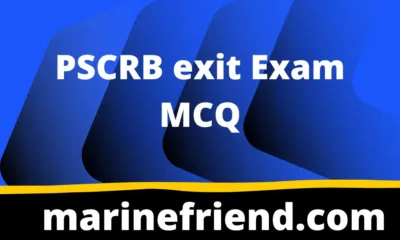PSSR
Pssr exit exam mcq with answers part 4

Pssr exit exam mcq with answers part 4
Here are some multiple-choice questions (MCQs) related to the PSSR (Personal Safety and Social Responsibilities) Exit Exam administered by DG Shipping, along with the correct answers:
Question: What is the primary focus of the PSSR course?
a) Advanced navigation techniques
b) Personal safety and social responsibilities on board
c) Engine room operations
d) Maritime law and regulations
Answer: b) Personal safety and social responsibilities on board
Question: In the context of PSSR, what does “Muster Station” refer to?
a) The ship’s navigation center
b) A designated assembly point for crew during emergencies
c) A recreational area on the ship
d) The location of lifebuoys
Answer: b) A designated assembly point for crew during emergencies
Question: What is the purpose of the “Man Overboard” drill?
a) To practice firefighting techniques
b) To simulate an emergency evacuation
c) To respond to a person falling into the water
d) To test the ship’s communication systems
Answer: c) To respond to a person falling into the water
Question: What type of equipment is used for providing artificial respiration in a medical emergency?
a) Fire extinguisher
b) Immersion suit
c) Automated External Defibrillator (AED)
d) Lifebuoy
Answer: c) Automated External Defibrillator (AED)
Question: According to PSSR, what is the correct procedure for using a fire extinguisher?
a) Direct towards flames and sweep in a circular motion
b) Spray in the air to create a barrier
c) Aim at the base of the fire, pull the pin, squeeze the handle, and sweep from side to side
d) Use only if the fire is near the escape route
Answer: c) Aim at the base of the fire, pull the pin, squeeze the handle, and sweep from side to side
Question: What is the purpose of the International Safety Management (ISM) Code?
a) To regulate cargo stowage
b) To provide guidelines for personal grooming
c) To set standards for the safe management and operation of ships
d) To determine the ship’s speed
Answer: c) To set standards for the safe management and operation of ships
Question: Why is it important for crew members to be familiar with the location of life-saving appliances on board?
a) To enhance communication with port authorities
b) To organize recreational activities
c) To respond quickly in emergency situations
d) To facilitate efficient cargo handling
Answer: c) To respond quickly in emergency situations
Question: In the context of PSSR, what does “Personal Protective Equipment” (PPE) include?
a) Ship’s navigation charts
b) Crew uniforms
c) Safety helmets, gloves, and life jackets
d) Recreational equipment
Answer: c) Safety helmets, gloves, and life jackets
Question: What is the significance of the Shipboard Safety Management System (SSMS)?
a) To regulate the ship’s recreational activities
b) To promote a culture of safety and prevent accidents
c) To organize social events on board
d) To determine the ship’s cargo capacity
Answer: b) To promote a culture of safety and prevent accidents
Question: According to PSSR, what is the primary responsibility of a crew member during a medical emergency?
a) Administering medication without delay
b) Notifying the ship’s captain and waiting for instructions
c) Performing first aid and assisting medical personnel
d) Ignoring the situation until the ship reaches the next port
Answer: c) Performing first aid and assisting medical personnel
Question: What is the purpose of the International Ship and Port Facility Security (ISPS) Code in relation to personal safety?
a) To regulate crew members’ working hours
b) To ensure proper navigation of the ship
c) To enhance and maintain the security of a ship
d) To establish standards for recreational facilities on board
Answer: c) To enhance and maintain the security of a ship
Question: During a fire emergency, what is the correct order of priority for evacuation?
a) Passengers first, crew second
b) Crew first, passengers second
c) Children first, adults second
d) Elderly first, younger individuals second
Answer: b) Crew first, passengers second
Question: In the context of PSSR, what does an “Emergency Escape Breathing Device” (EEBD) provide protection against?
a) Chemical spills
b) Fire and smoke inhalation
c) Drowning
d) Extreme cold weather
Answer: b) Fire and smoke inhalation
Question: What is the primary responsibility of a crew member during an abandoned ship drill?
a) Activate the ship’s alarm system
b) Proceed directly to the assigned lifeboat station without delay
c) Gather at the nearest convenient location
d) Wait in the cabin until further instructions are given
Answer: b) Proceed directly to the assigned lifeboat station without delay
Question: According to the SOLAS Convention, what is the purpose of the Ship Security Alert System (SSAS)?
a) To signal the ship’s arrival at its destination
b) To alert authorities of a security threat or piracy incident
c) To regulate the ship’s navigation routes
d) To notify the crew of upcoming social events
Answer: b) To alert authorities of a security threat or piracy incident
Question: What is the purpose of the Safety Data Sheet (SDS) on board a ship?
a) To outline the ship’s emergency response procedures
b) To detail the properties and hazards of chemicals on board
c) To provide information on the ship’s navigational equipment
d) To record the ship’s maintenance history
Answer: b) To detail the properties and hazards of chemicals on board
Question: According to PSSR, what is the role of a crew member in maintaining ship stability?
a) Monitoring the ship’s speed
b) Ensuring proper cargo stowage and securing
c) Conducting regular engine inspections
d) Overseeing the navigation watchkeeping duties
Answer: b) Ensuring proper cargo stowage and securing
Question: What does the term “Metacentric Height” (GM) refer to in the context of ship stability?
a) The height of the ship’s mast
b) The depth of the ship’s keel
c) The distance between the center of gravity and the metacenter
d) The distance from the ship’s bow to the stern
Answer: c) The distance between the center of gravity and the metacenter
Question: According to the ISM Code, what is the purpose of the Designated Person Ashore (DPA)?
a) To lead the ship’s recreational activities
b) To coordinate security measures on board
c) To oversee the ship’s medical facilities
d) To serve as a point of contact for ensuring effective communication
Answer: d) To serve as a point of contact for ensuring effective communication
Question: Why is it important for crew members to understand and follow the Shipboard Safety Management System (SSMS)?
a) To organize social events on board
b) To ensure compliance with environmental regulations
c) To enhance communication with port authorities
d) To promote a culture of safety and prevent accidents
Answer: d) To promote a culture of safety and prevent accidents
Question: What is the purpose of the “International Maritime Dangerous Goods (IMDG) Code” on board a ship?
a) To regulate crew members’ working hours
b) To ensure proper navigation of the ship
c) To establish guidelines for the safe transport of dangerous goods by sea
d) To determine the ship’s cargo capacity
Answer: c) To establish guidelines for the safe transport of dangerous goods by sea
Question: In the context of PSSR, what is the role of crew members during a security drill?
a) To practice firefighting techniques
b) To simulate man overboard situations
c) To respond to potential security threats and emergencies
d) To showcase navigation skills
Answer: c) To respond to potential security threats and emergencies
Question: According to the ISPS Code, what is the purpose of Restricted Access Areas on board a ship?
a) To store confidential documents
b) To limit access to authorized personnel for security reasons
c) To conduct emergency drills
d) To house recreational facilities
Answer: b) To limit access to authorized personnel for security reasons
Question: What is the primary responsibility of a crew member during a security threat on board?
a) Ignore the threat and continue regular operations
b) Report the threat only to the ship’s captain
c) Implement the ship’s security plan and notify relevant authorities
d) Evacuate the ship immediately
Answer: c) Implement the ship’s security plan and notify relevant authorities
Question: Why is it crucial for crew members to be familiar with the International Regulations for Preventing Collisions at Sea (COLREGs)?
a) To enhance communication with port authorities
b) To regulate cargo stowage procedures
c) To ensure compliance with environmental regulations
d) To prevent collisions and ensure safe navigation
Answer: d) To prevent collisions and ensure safe navigation
Question: What is the purpose of the Shipboard Oil Pollution Emergency Plan (SOPEP) according to SOLAS regulations?
a) To regulate crew members’ working hours
b) To ensure proper navigation of the ship
c) To establish procedures for responding to oil spills
d) To determine the ship’s cargo capacity
Answer: c) To establish procedures for responding to oil spills
Question: During a medical emergency on board, what communication equipment should be used to seek assistance?
a) Fire extinguisher
b) VHF Radio
c) GPS
d) Echo Sounder
Answer: b) VHF Radio
Question: In the context of PSSR, what is the purpose of a “Safety Meeting” on board a ship?
a) To organize social events and team-building activities
b) To discuss recreational plans for the crew
c) To review safety-related matters and promote awareness
d) To address routine maintenance issues
Answer: c) To review safety-related matters and promote awareness
Question: What is the significance of the Global Maritime Distress and Safety System (GMDSS) in maritime communication?
a) To enhance navigation equipment
b) To regulate crew members’ working hours
c) To provide guidelines for cargo handling
d) To ensure effective and reliable communication during emergencies
Answer: d) To ensure effective and reliable communication during emergencies
Question: According to the Maritime Labour Convention (MLC), what rights does it address for seafarers?
a) Regulation of cargo stowage
b) Standards for ship stability
c) Working conditions and seafarers’ rights
d) Navigation equipment requirements
Answer: c) Working conditions and seafarers’ rights
These questions cover a range of topics related to personal safety, security, and regulations relevant to the PSSR Exit Exam. Make sure to review specific materials provided by DG Shipping for the most accurate information. If you have more questions or if there’s anything else I can help you with,
pssr exit exam (refresher and new) part-1
pssr exit exam (refresher and new) part-2
pssr exit exam (refresher and new) part-3
Pssr exit exam mcq with answers part 4
pssr exit exam (refresher and new) part-5
pssr exit exam (refresher and new) part-6
pssr exit exam (refresher and new) part-7
pssr exit exam (refresher and new) part-8
pssr exit exam (refresher and new) part-9
pssr exit exam (refresher and new) part-10
Also read:
OCTCO exit exam questions and answers
MFA Exit exam questions and answers
PST Exit exam questions and answers
these questions are generated from the e-learning website of DG shipping.
-

 SEAFARERS4 years ago
SEAFARERS4 years agoBsid dg shipping email id and contacts
-

 SEAFARERS4 years ago
SEAFARERS4 years agocommerce se merchant navy kar sakta hai kya?
-

 RPSL4 years ago
RPSL4 years agoBlacklisted RPSL companies 2021/2022/PART-2
-

 COLLEGES4 years ago
COLLEGES4 years agoGp rating college list approved by dg shipping in india
-

 RPSL4 years ago
RPSL4 years agoBlacklisted RPSL companies 2021/2022/PART-1
-

 RPSL4 years ago
RPSL4 years agodg shipping approved company
-

 RPSL4 years ago
RPSL4 years agorpsl shipping company list in Belapur
-

 PSCRB2 years ago
PSCRB2 years agoPSCRB exit Exam MCQ-1










